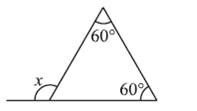The exterior angle theorem is a theorem in elementary geometry which states that the exterior angle of a triangle is equal to the sum of the two remote interior angles.
A triangle has three corners, called vertices. The sides of a triangle that come together at a vertex form an angle. This angle is called the interior angle. In the picture below, the angles a, b and c are the three interior angles of the triangle. An exterior angle is formed by extending one of the sides of the triangle; the angle between the extended side and the other side is the exterior angle. In the picture, angle d is an exterior angle.
The exterior angle theorem says that the size of an exterior angle at a vertex of a triangle equals the sum of the sizes of the interior angles at the other two vertices of the triangle. So, in the picture, the size of angle d equals the size of angle a plus the size of angle c.

Given: In ∆ABC, angle ACD is the exterior angle.
To prove:  ACD =
ACD =  ABC +
ABC +  BAC (here,
BAC (here,  ACD denotes the size of the angle ACD)
ACD denotes the size of the angle ACD)
Proof:
| Statements | Reason |
|---|
In ∆ABC,  a + a +  b + b +  c = 180°------[1] c = 180°------[1] | Sum of the measures of all the angles of a triangle is 180° |
Also,  b + b +  d = 180°-------[2] d = 180°-------[2] | Linear pair axiom |
∴  a + a +  c + c +  b = b =  b + b +  d d | From [1] and [2] |
∴  a + a +  c + c +  b b b b d d | |
∴  d = d =  a + a +  c c |
i.e.  ACD = ACD =  ABC + ABC +  BAC BAC | |
Hence, proved.
Best Wishes !@




